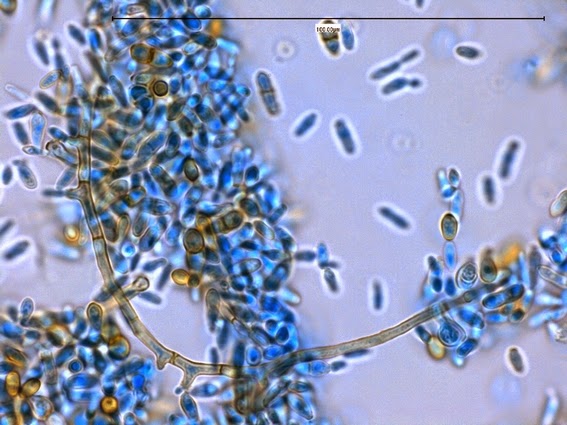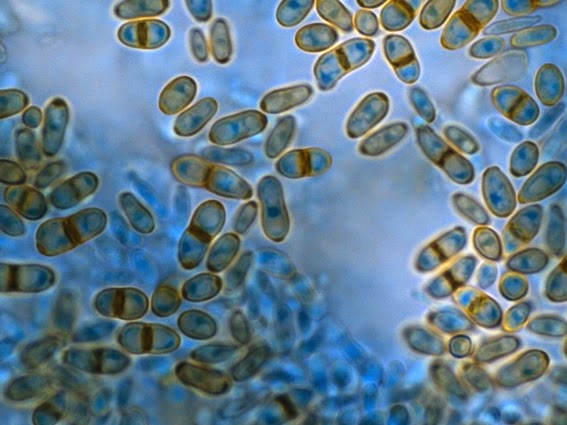Monday 31 March 2014
Hortaea werneckii
Hortaea werneckii -Mould (Phaeoannellomyces werneckii)
Ecology:
Hortaea werneckii is a saprophytic
fungus which can be found in tropical and sub-tropical soils, compost, and
decaying wood. This fungus is also halophilic
as it has been isolated from salted foods, saline waters and natural saltpans,
growing in salt concentrations of up to 10%.
Pathogenicity:
H.werneckii is
the etiological agent of superficial skin infections known as tinea nigra. This infection usually manifests itself as
brown to black macules which are most often found on the palms of the
hands. The appearance may initially resemble
that of malignant melanoma.
Macroscopic
Morphology:
Hortaea werneckii
is a rather slow growing fungus which initially appears as shiny black, slimy
or mucoid yeast. As the colony matures,
development of aerial hyphae may give the colony a velvety texture. The reverse also has a rather non-nondescript
brown-black colour.
Hortaea werneckii SAB 16 days at 30˚C (Nikon)
Reverse: (not shown) appears much like the surface, perhaps slightly more olivaceous in colour.
Right: single colony incubated for approximately one month shows a slight velvety texture.
Aerial mycelia develop and acquire the olivaceous black
colour as they age. Septate hyphae may
be rather wide, reaching up to 6 µm in width.
Intercalary or lateral conidiogenous (annellide[i])
cells develop along the hyphae which produce the conidia (annelloconidia). When released the annelloconidia show a
prominent annellated ring, 1 -2 µm wide where once attached.
Annelloconidia are also hyaline (clear) becoming
translucent olivaceous brown-black in maturity.
They are smooth-walled and have a broad ellipsoidal appearance (7.0 –
9.5 µm X 3.5 – 4.5 µm). Annelloconidia
are 1 to 2 celled and the internal cell wall or septum is usually deeply
pigmented. With aging the annelloconidia
may develop into chlamydoconidia-like aggregates (chlamydospores).
Hortaea werneckii - At low magnification there is not much to see other that a sea of cells (conidia)
(KOH, 250X, DMD-108)
Hortaea werneckii -brown or olivaceous pigmented conidia are visible
(KOH, 400X, DMD-108)
Hortaea werneckii - two celled conidia can now be distinguished.
(KOH, 400+10X, DMD-108)
Hortaea werneckii -Pigmented, septate hyphae with lateral annellides.
(LPCB, 1000X, DMD-108)
Hortaea werneckii -Here we can see the broadly ellipsoidal, two-celled annelloconidia. Mature conidia have the brown pigmentation while younger cells stain more intensely with the Lactophenol Cotton Blue (LPCB). One end of the annelloconidia usually stains darker indicating the location of the annellated ring or the point where it was previously attached to the conidogenous annellide.
(1000X, LPCB, DMD-108)
Hortaea werneckii -Another view of a curving septate hyphae surrounded by numerous free conidia. Annellides can be seen at various points along the hyphae from where the conidia are produced.
(1000X, LPCB, DMD-108)
Hortaea werneckii -The arrow points to an annelide with its developing annelloconidium still attached. Also seen is a pigmented and septate hyphal element near the top left as well as annelloconidia in various states of maturity.
(1000X, LPCB, DMD-108)
Hortaea werneckii -Another view of a developing annelloconidium attached to the parent annellide.
(1000+10X, LPCB, DMD-108)
Hortaea werneckii -and one more. Annelloconidium developing in the center of the photo.
(1000+10X, LPCB, DMD-108)
Hortaea werneckii -The primarily two-celled conidia, or more precisely annelloconidia are seen here in various states of pigmentation. Note that the septum dividing the two cells is darkly stained, as is one end, where the annelloconidium was once attached to its parent annnellide.
(1000+10X, LPCB, DMD-108)
Hortaea werneckii - With aging the annelloconidia
may develop into chlamydoconidia-like aggregates (chlamydospores) as seen here in the center of the photograph.
(1000+10X, LPCB, DMD-108)
Hortaea werneckii -The annelloconidia can themselves "bud" and act as annellides, producing annelloconidia as seen here.
(400X, LPCB, 400X -adhesive tape mount)
Hortaea werneckii -germination of an annelloconidium at top. Not also the bud developing at the bottom of the two celled annelloconidium.
(1000+10X, LPCB, DMD-108)
Physiology:
-Does not grow at 37˚C
-Nitrate +ve
-Urease +ve
-Halophilic up to 10%
Differentiation:
The annellated zones on Hortaea werneckii are much broader than those of Exophiala species. Lack of growth at 37˚C also distinguishes the
two.
[i]
Annellide –A specific conidiogenous cell that produces conidia in succession,
each leaving a ring-like collar on the cell wall when released. ‘Annello’ prefix simply specifies the type of
conidiogenous cell or conidia which is produced.
* * *
Subscribe to:
Posts (Atom)
















.jpg)























